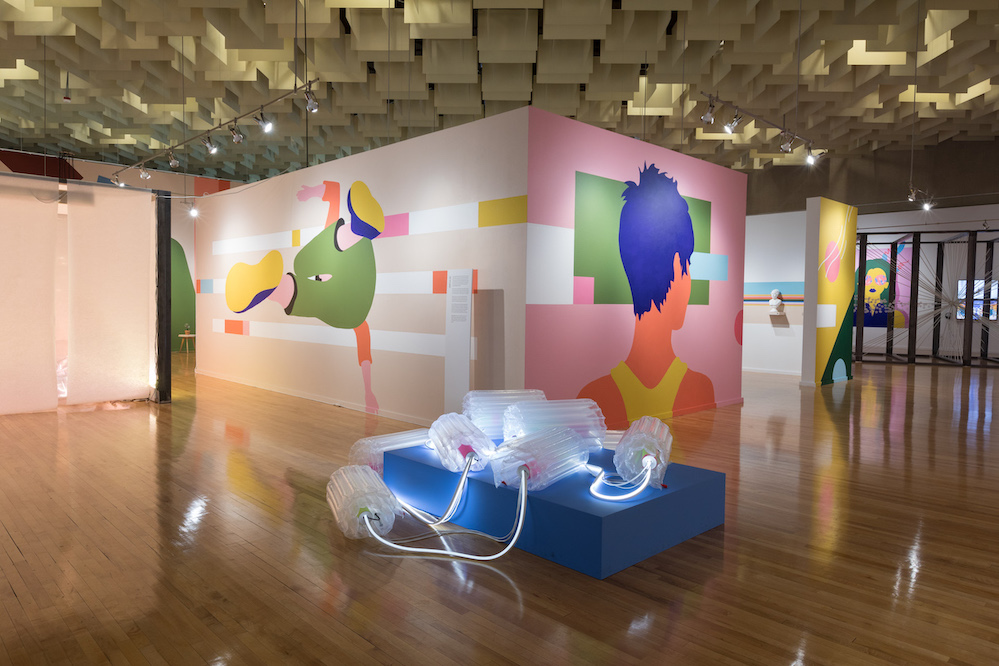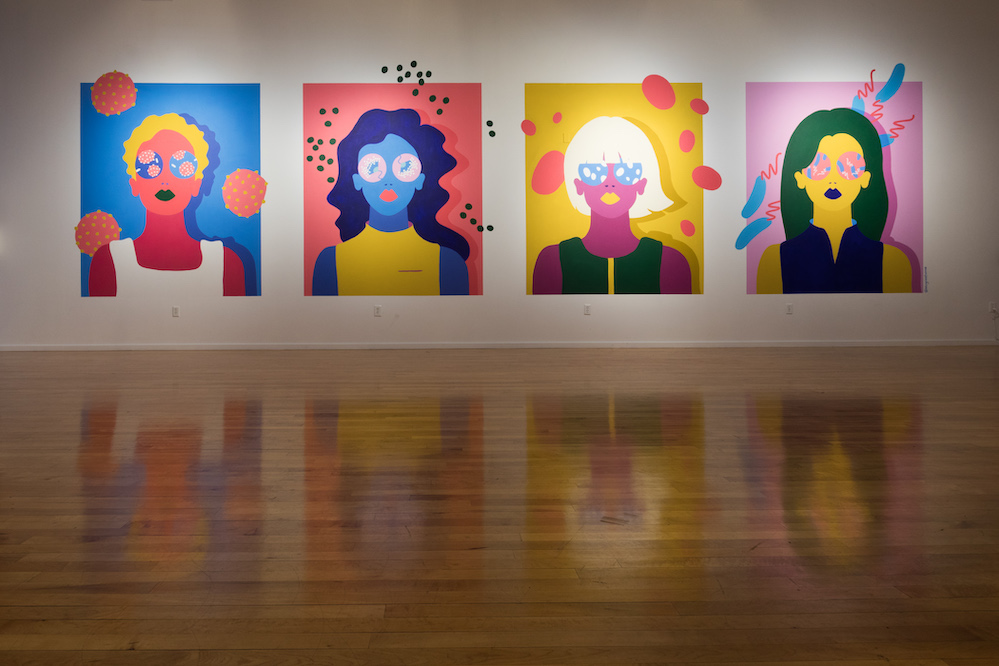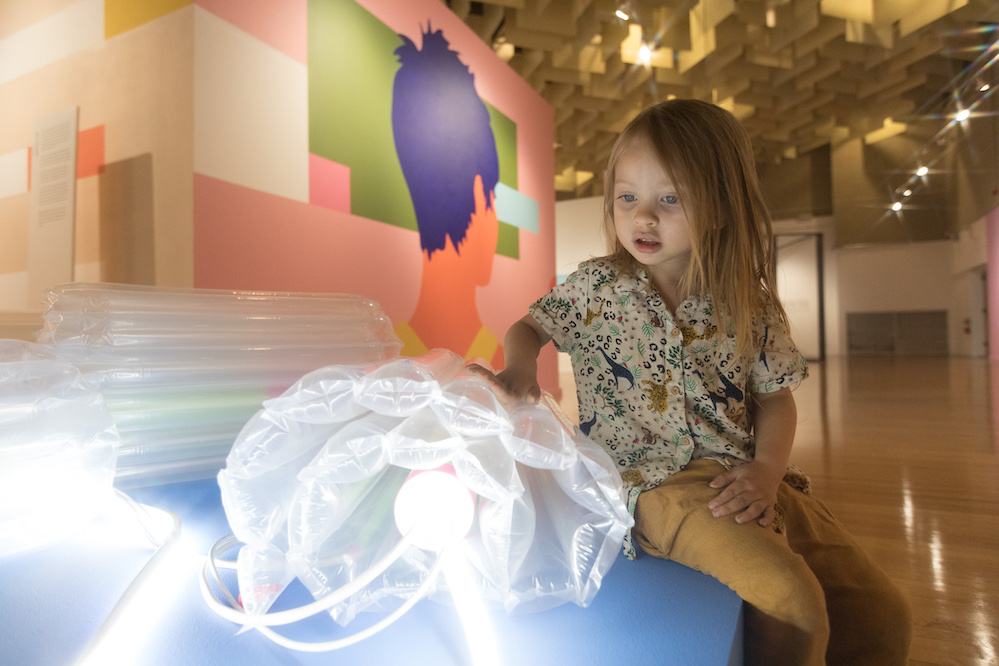
Barrick Museum of Art volunteer Michael Freborg has spent some time thinking about Amanda Phingbodhipakkiya’s Connective Tissue exhibition (September 13, 2019 – February 22nd, 2020). He writes:
Working at a writing center, I often collaborate with my co-workers when tutoring
students. We are all experienced writers who come from a variety of disciplines and
backgrounds, and each of us has our particular strengths. But sometimes students have questions we don’t know the answers to, so we rely on each other to provide the missing information. The whole process is communal. The students as well are encouraged to actively participate, often yielding productive results. As tutors, we function more as a system than as individual cells. And in doing so, we usually have the most significant impact. This is the point that artist and neuroscientist Amanda Phingbodhipakkiya wants to make with Connective Tissue. “The reach of our actions is limited when we operate independently,” she says, “but can be exponential when we work together.” She believes that the most positive change occurs through social interaction, when people are united as one collective group with a common purpose.
Throughout her exhibition, she emphasizes community, and uses her scientific knowledge to examine human experiences and to bring to light processes that are imperceptible to the senses. Like Justin Favela and Romero Gomez in Sorry for the Mess, Phingbodhipakkiya exaggerates the scale of her artwork, drawing attention to the invisible. But while Favela and Gomez highlight human workers who go unnoticed, yet are still part of the physical world, she takes it a step further. Her large-scale molecular and subatomic models illustrate that which is literally invisible to the naked eye – the building blocks, she says, that are essential to our very existence.
In one such piece, titled There Are No Particles, Only Fields, Phingbodhipakkiya depicts a process in quantum field theory, which suggests that electrons are not discrete particles, but localized vibrations in an invisible field. Theoretically, these vibrations can be detected, but they cannot be seen. Here, the artist brings the infinitesimal realm into the physical world with a 10-foot steel-framed, three-dimensional installation made of 750 feet of shock chord. The model portrays a photon being passed from one electron to another (which occurs when two electrons shift their orbits around an atom). It is loosely based on American scientist Richard Feynman’s diagram depicting the interaction of subatomic particles.

Her wall murals are vibrant and colorful, depicting women in blissful states while adding scientific elements to encourage young girls to join the fields of science. The four women in the portraits along the back wall of the gallery seem relaxed, dressed in comfortable attire, and at first glance, appear to be wearing sunglasses that look like they are reflecting fruit. But upon closer inspection, the mirrored shades covering their eyes are actually Petri dishes containing microorganisms. Additional microbes float around the four women, making visible the ecosystems of bacteria, yeast, and fungi that exist around us. Other murals show women embracing each other, reinforcing relationships, and emphasizing a supportive community. Phingbodhipakkiya sees women as the “connective tissue” of communities. They are the ones, she says, that keep everything “humming and running smoothly.”
She also pays tribute to prominent women in the science community, both living and from the past. One of the artworks in the Center Gallery, titled In the Company of Scientists, consists of twenty small-scale busts adorning individual shelves on four walls. The busts are 3D printed in pure white plastic, referencing the marble statues of Ancient Rome and Greece, which at one time were brightly painted, but lost their color over the centuries. What makes this collection unique is that all the faces are of women pioneers from the disciplines of science, technology, engineering, and mathematics (STEM), including doctors, scientists, and astronauts, many of whom are Nobel Prize winners. Painted multi-colored lines run along the walls behind the busts, symbolizing unity and progress. Every bust has a QR label that allows viewers to access an online profile of the individual via their smartphones.
Its companion piece, Beyond Curie, celebrates 45 women in STEM. Thirty-two of their printed portraits rest on shelves on the center wall. The display also offers an augmented reality (AR) experience. When visitors download the Beyond Curie AR app from the Apple or Android Store, or from beyondcurie.com/app, and hold their smartphones to the portraits, they will be able to see additional information about these women pioneers on their screens. The text beside the display in the room mentions that only 7.5% of the over 5,000 public statues displayed in the United States are of women. Like Favela and Gomez, Phingbodhipakkiya celebrates an overlooked segment of our society who, despite their contributions to the world, are often ignored or forgotten. This is particularly important to Phingbodhipakkiya, because she, herself, is a member of the STEM community. And with the busts and portraits of these women pioneers, she hopes to excite and motivate other women to join in their footsteps.
Phingbodhipakkiya designed her artwork so that visitors could get up close and personal. Her interactive dioramas encourage involvement, inviting viewers to use their senses, particularly touch, which she sees as an essential ingredient in forming connections with people. For it is the concept of touch that reverberates throughout the exhibition. One such display, Binary Outcomes utilizes five wooden boxes aligned horizontally along the wall, each with a pressure- activated sensor and headset for visitors to listen. Each box has a particular instrument assigned to it, such as an oboe, flute, clarinet, or horn. When a sensor is pressed on one of the boxes, a few notes are played. Visitors pushing two or more sensors at the same time will be able to hear the instruments playing together. When all five sensors are pressed at once, the entire quintet of instruments will play a melody. For this display, the artist uses the analogy of a forest fire building its force from strong winds, dry grass, and lack of moisture in the air. “Everything that becomes massive, starts small and gains momentum,” she says.

This theme continues in Campfire, a mock camping tent that, like its counterparts, incorporates physical contact. Inside the tent are three inflatable cushions facing each other. Campfire is one of two exhibition pieces where Phingbodhipakkiya utilizes inflatable devices to contain and sculpt air, she explains, to bridge an intangible element with the physical world. When one or two of these air pressure-sensored seats are sat upon, cool fluorescent lights come on. When all three cushions are occupied, a warm glow is emitted, giving participants a completely different visual experience. Campfire shows that the more people that are involved in a conversation, the better the chance that ideas will spark from it, thus creating a tipping point. Again, she uses the metaphor of a fire burning brighter and stronger as increasing factors propel it to critical mass. As in Binary Outcomes, the idea that one person alone is incapable of making significant change is evident in the exercise. And like Binary Outcomes, the more visitors who participate in the activity, the stronger the momentum, and the greater the change that occurs.
The sculpture next to Campfire, titled Impulse, not only incorporates touch, but brings attention to the 5 million Americans who suffer from neurodegenerative disorders, such as multiple sclerosis and Alzheimer’s, as well as the families and caregivers who are also negatively impacted by the diseases. As with Campfire, the artist uses inflatable cushions to mold air. Here she uses them as a tool to explain a biological process. For this display, she uses 10 blown-up transparent pillows connected by a long cord to simulate the effects of myelin, a fatty substance that coats brain neurons, allowing them to send electrical pulses across the nervous system more efficiently. When myelin is damaged or lost, it can cause brain activity to weaken, slow, or cease. The pillows illustrate this effect when pressed. The more thickly padded ones send stronger and brighter light signals farther down the cord, while the thinly cushioned ones discharge flickering and erratic streams of light. Here again she exaggerates the scale of her artwork to bring a microscopic element, invisible to the naked eye, into the visible world. And its interactive quality gives its participants a better understanding of the process than simply reading about it, allowing them to use both sight and touch to enhance their learning potential.
Perhaps the most interactive exhibition is Strange Sequences, an ethical exercise that encourages critical thinking and group discussion. Touching a button on one of the six wooden boxes yields a receipt-like printout describing a hypothetical near-future scenario involving climate change, genetics, or biotechnology. There are four multiple choice answers, labeled A through D, ranging from cautious (testing it first for about fifty years) to proceeding immediately and then waiting to see what happens. One scenario is an experimental vaccine that would make children smarter, but increase their risk of having Alzheimer’s disease later in life. There are four transparent bins with corresponding letters where visitors can drop their answers. This creates a physical representation of the votes, showing the large number of participants, and alluding to the many conversations that may have occurred. From here, the artist can make inferences about the local community, such as their cultural or religious backgrounds, family upbringing, and other factors that might have influenced their answers. Like the other displays in the gallery, the theme centers around how people in numbers are more likely to bring about positive change than individuals alone. The exhibition has been running for three months and the four bins are nearly full, each containing what looks like hundreds of tapes. The bin labeled “A” appears to be lagging behind the others by almost a foot. This suggests that the young participants, comprised of middle-schoolers and UNLV students in their early twenties, err on the side of caution when it comes to moral dilemmas, especially when untested side effects are involved. I personally witnessed a group of five middle school students clustered around Strange Sequences enthusiastically discussing one of its topics – just the kind of viewer participation Phingbodhipakkiya seeks to create with her work.

All photographs by Mikayla Whitmore.